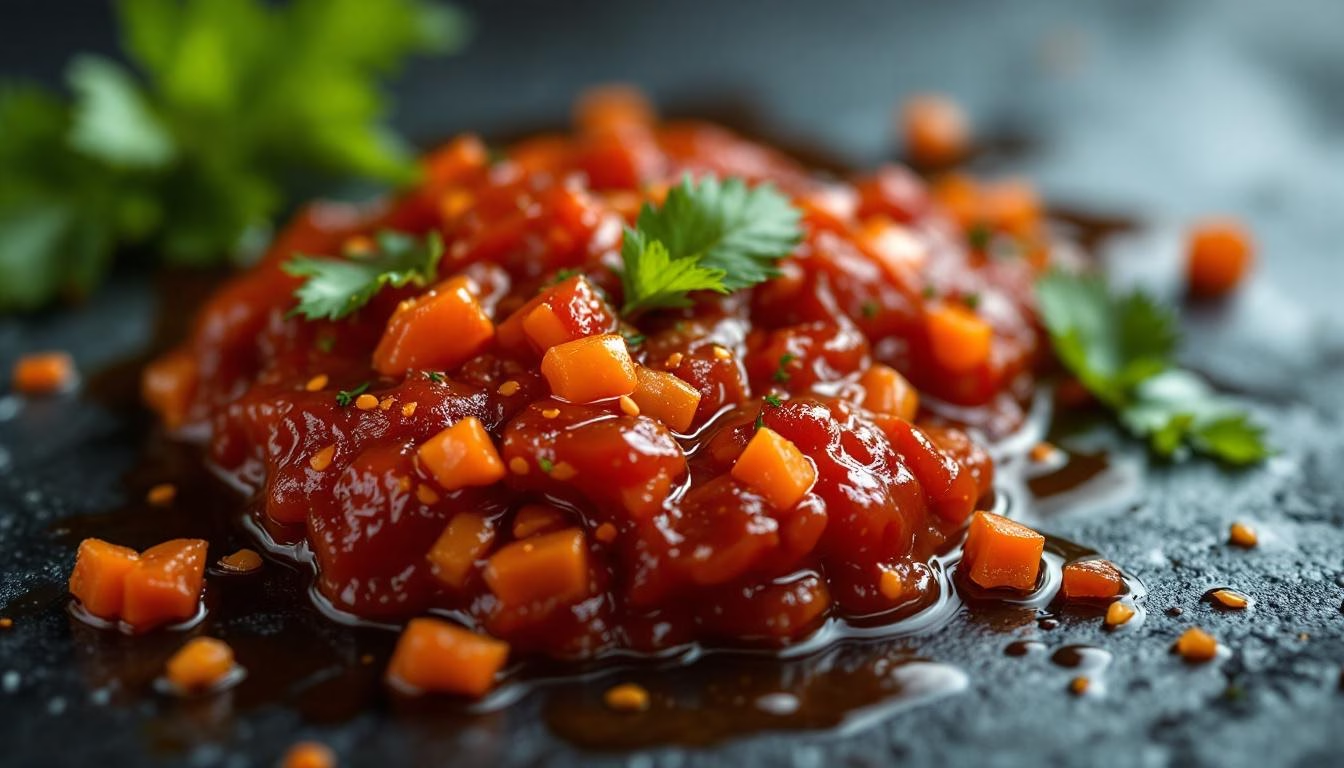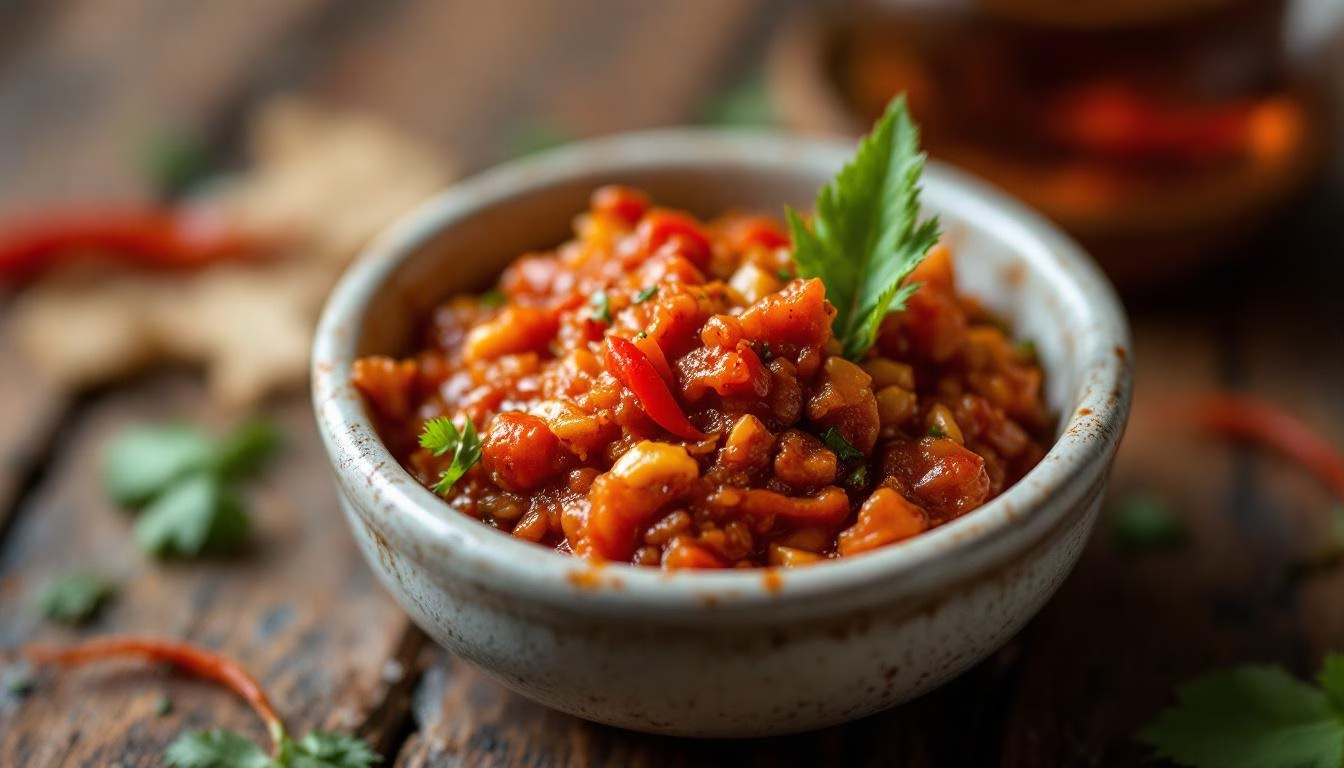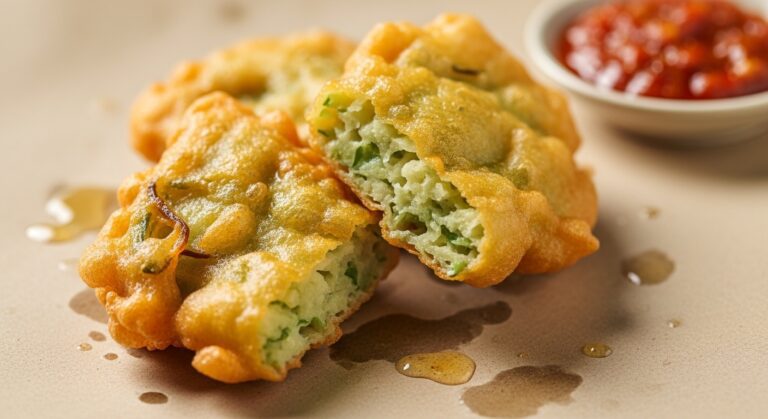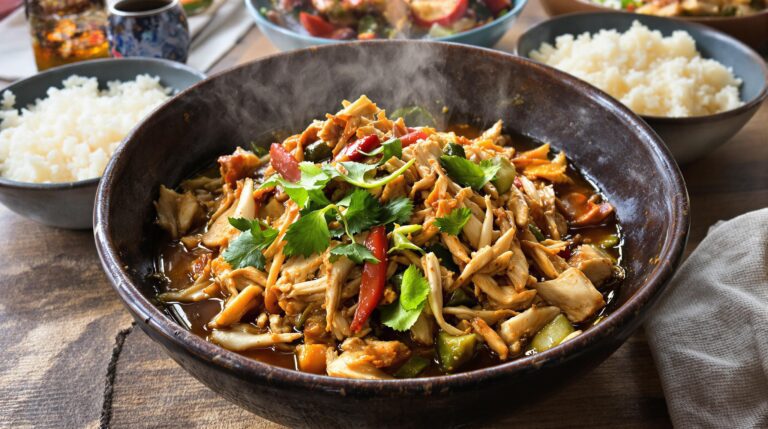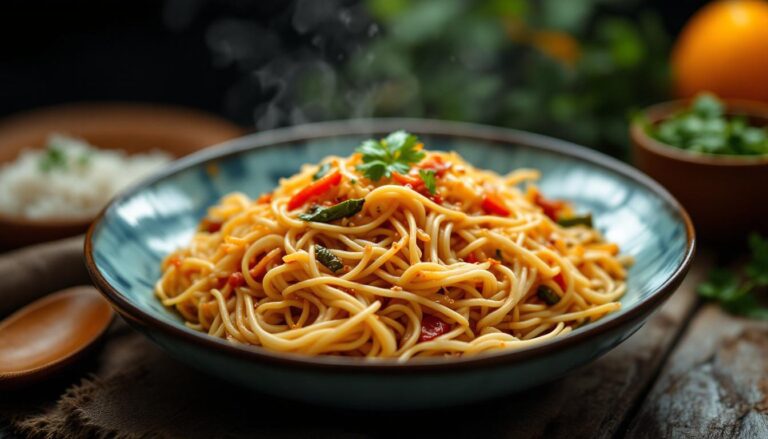Sambal Matah Recipe: Fresh Balinese Condiment
Fresh Sambal Matah Recipe: The Ultimate Raw Balinese Condiment Guide – I’ll never forget the first time I encountered sambal matah at a tiny warung in Ubud, served alongside the most perfectly grilled fish I’d ever tasted.
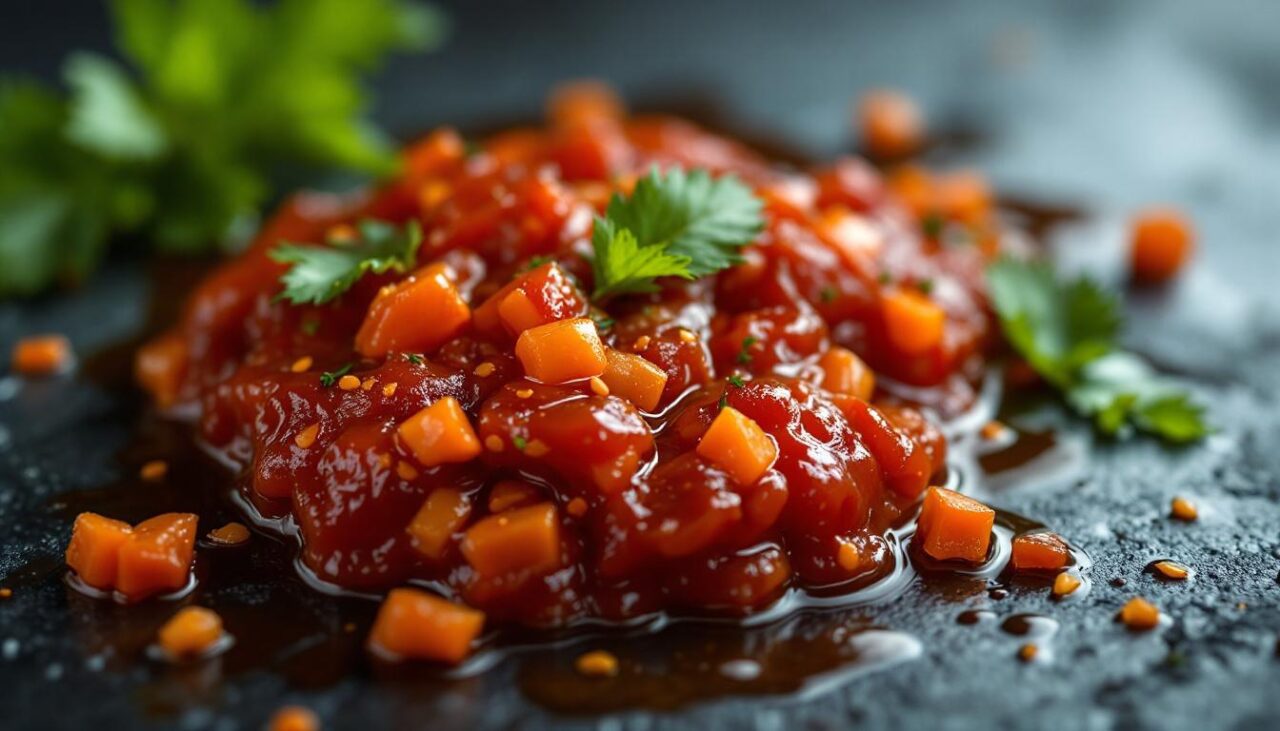
Sambal Matah (Raw Balinese Condiment)
Ingredients
- 6 shallots (or one medium red onion, thinly sliced)
- 2 cloves garlic (minced)
- 2 makrut lime leaves ((aka kaffir lime leaf) thinly sliced, stem discarded)
- 3 bird’s eye chilies ((or to tast) destemmed and thinly sliced)
- ½ teaspoon salt
- 1 teaspoon palm sugar (or coconut sugar, or brown sugar)
- 4 inches lemongrass (( 10 cm.))
- 2 tablespoons refined coconut oil
- 4 teaspoons lime juice
Instructions
- In a mixing bowl, combine thinly sliced shallots (or red onion), garlic, thinly sliced makrut lime leaves, minced bird’s eye chilies, salt, and sugar.
- Remove the tough outer leaves from the lemongrass, leaving only the tender inner white portion.
- Finely mince the tender white lemongrass; you should have about two tablespoons.
- Heat the coconut oil in a small pan over medium heat. When hot, add the minced lemongrass and cook for 1–2 minutes to infuse the oil.
- Pour the hot lemongrass oil into the prepared vegetables and gently mix until well combined.
- Add fresh lime juice. Let the Sambal Matah cool and allow the flavors to absorb into the shallots for at least 20 minutes before serving.
Nutrition
The vendor, a weathered Balinese woman with kind eyes, watched me take my first tentative bite and then break into what I can only describe as pure culinary joy.
This wasn’t the fiery, cooked sambal I knew from Indonesian restaurants back home — this was something entirely different, something alive and electric on the tongue.
The sambal matah was a revelation: paper-thin shallot slices that seemed to dance with heat, aromatic lime leaves that perfumed every bite, and bird’s eye chilies that delivered just enough fire to make you pay attention without overwhelming the delicate balance.
What struck me most was how fresh it all tasted — like someone had captured the essence of a tropical garden and somehow made it edible.
The vendor smiled knowingly as I devoured every last bit, then proceeded to teach me the recipe right there on the spot, her hands moving with practiced grace as she demonstrated the proper way to slice shallots “like paper” and infuse coconut oil with lemongrass.
That afternoon changed my relationship with condiments forever.
I realized I’d been thinking too small, too cooked, too safe.
Here was proof that sometimes the most extraordinary flavors come from the simplest techniques — no long simmering, no complex spice blending, just pristine ingredients treated with respect and combined with an understanding of how flavors marry and intensify over time.
Sambal Matah Recipe: Bali’s Famous Raw Shallot Condiment
Sambal matah represents everything I love about Indonesian cuisine: it’s bold without being aggressive, complex yet surprisingly simple to execute, and absolutely bursting with the kind of fresh, vibrant flavors that make you wonder why you ever thought condiments had to come from a jar.
This raw Balinese condiment is fundamentally different from its cooked cousins — instead of long simmering to meld flavors, sambal matah relies on the gentle heat of warm coconut oil and time to transform its ingredients into something magical.
The beauty of this Sambal Matah (Raw Balinese Condiment) recipe lies in its restraint.
Unlike many sambals that announce themselves with aggressive heat, sambal matah whispers its complexity through layers of aromatics.
The shallots provide sweetness and bite, the makrut lime leaves (also called kaffir lime leaves) contribute an almost floral citrus note that’s impossible to replicate with regular lime zest, and the lemongrass-infused oil ties everything together with its lemony, almost grassy perfume.
What fascinates me most about sambal matah is how it bridges the gap between condiment and salad.
It’s substantial enough to stand on its own as a side dish, yet versatile enough to elevate everything from grilled meats to simple steamed rice.
In Bali, you’ll find it accompanying everything from bebek betutu (slow-roasted duck) to simple grilled fish, and each pairing reveals new dimensions of its flavor profile.
Essential Ingredients for Perfect Sambal Matah
The magic of this Sambal Matah (Raw Balinese Condiment) recipe starts with understanding that every ingredient plays a crucial role, and there are very few acceptable substitutions.
Let me walk you through what you’ll need and why each component matters.
The Foundation: Shallots and Aromatics
Shallots are the star of this show, and their preparation is absolutely critical.
You want them sliced so thin they’re almost translucent — think mandoline-thin if you have one, or practice your knife skills if you don’t.
I’ve tried this recipe with regular yellow onions when shallots weren’t available, and while it’s still delicious, you lose some of that delicate sweetness that makes authentic sambal matah so special.
Red onions work better as a substitute than yellow, but honestly, it’s worth seeking out proper shallots.
The garlic should be minced fine enough that it distributes evenly throughout the mixture without overwhelming any single bite.
Bird’s eye chilies (cabe rawit in Indonesian) provide the heat, and their intensity can vary wildly, so start conservatively — you can always add more, but you can’t take it back.
The Aromatic Heroes: Lime Leaves and Lemongrass
Makrut lime leaves are absolutely non-negotiable in authentic sambal matah.
These glossy, double-lobed leaves have a citrusy, almost pine-like aroma that’s completely unique.
Remove the tough central stem and slice the leaves as thinly as possible — they should look like green confetti when you’re done.
If you absolutely cannot find fresh makrut lime leaves, frozen ones work in a pinch, but dried leaves or lime zest just won’t give you the same result.
Lemongrass requires a bit of technique to prepare properly.
You’ll want to remove the tough outer layers until you reach the tender, pale inner core.
This should mince easily and smell intensely lemony when you’re done.
The key is infusing the coconut oil with this minced lemongrass — it’s what transforms ordinary coconut oil into something aromatic and complex.
Step-by-Step Sambal Matah Recipe Instructions
Making sambal matah is more about technique and timing than complex cooking skills, but the details matter enormously.
This isn’t a recipe where you can be cavalier about prep work — the beauty lies in the precision.
Preparing Your Mise en Place
Start by getting all your aromatics ready before you touch the coconut oil.
In a medium mixing bowl, combine your paper-thin shallot slices, minced garlic, sliced makrut lime leaves, and minced bird’s eye chilies.
Add the salt and palm sugar (coconut sugar or brown sugar work fine as substitutes), and give everything a gentle toss to distribute the seasonings.
This is where patience pays off — take your time with the knife work.
Those shallots should be so thin you can almost see through them, and the lime leaves should be mere slivers.
I learned the hard way that thick slices don’t absorb the flavors the same way, and you end up with harsh bites of raw shallot instead of the mellow, sweet result you’re after.
The Lemongrass Oil Magic
Here’s where the real technique comes in.
Heat your coconut oil in a small pan over medium heat — you want it hot enough to sizzle when you add the lemongrass, but not so hot that it burns immediately.
When you add the minced lemongrass, it should bubble gently and release an incredible aroma within seconds.
Cook the lemongrass for just 1-2 minutes, stirring constantly.
You’re not trying to brown it, just awaken its oils and infuse them into the coconut oil.
The mixture should smell intensely lemony and aromatic.
Remove from heat immediately when the lemongrass becomes fragrant — overcooking will make it bitter.
Bringing It All Together
Pour the hot lemongrass oil directly over your prepared aromatics.
This is the moment where the magic happens — the heat from the oil will slightly “cook” the shallots and garlic, taking away their harsh raw edge while preserving their crisp texture.
The sizzling sound is exactly what you want to hear.
Gently mix everything together, making sure the oil coats all the ingredients evenly.
Add the fresh lime juice last — its acidity helps balance the richness of the oil and brightens all the other flavors.
The lime juice also helps preserve the vibrant colors of your ingredients.
Pro Tips for Sambal Matah Success
After making this Sambal Matah (Raw Balinese Condiment) recipe countless times, I’ve learned a few tricks that make the difference between good and extraordinary results.
Timing and Temperature Secrets
The temperature of your lemongrass oil when you pour it over the aromatics is crucial.
Too cool, and you won’t get that slight cooking effect that mellows the shallots.
Too hot, and you’ll end up with wilted, overcooked vegetables instead of the crisp-tender texture you want.
The oil should be hot enough to sizzle vigorously when it hits the shallots, but not smoking.
Let your finished sambal matah rest for at least 20 minutes before serving, but honestly, it’s even better after an hour.
This resting time allows the flavors to marry and the shallots to absorb the aromatic oil.
I often make it in the morning for dinner that evening — the flavors continue to develop and mellow throughout the day.
Storage and Serving Wisdom
Sambal matah is best served at room temperature, and it will keep in the refrigerator for up to three days, though it’s definitely at its peak within the first 24 hours.
The shallots will gradually lose their crisp texture over time, but the flavor remains delicious.
I actually prefer it slightly softened after a day in the fridge — the texture becomes more relish-like.
Never store sambal matah in a metal container, as the acidity from the lime juice can react with certain metals.
Glass or ceramic containers work best, and always use a clean spoon when serving to avoid contamination.
Creative Variations and Adaptations
While traditional sambal matah is perfect as-is, I’ve experimented with several variations that respect the original while adding new dimensions of flavor.
Heat Level Adjustments
For those who prefer milder heat, you can reduce the bird’s eye chilies or substitute with milder varieties like jalapeños (though you’ll lose some authenticity).
Conversely, if you’re a heat seeker, try adding a small amount of minced Thai chilies or even a tiny bit of habanero — just remember that the heat will intensify as the sambal sits.
Textural Variations
I’ve had success adding thinly sliced cucumber for extra crunch, or a handful of fresh herbs like Thai basil or cilantro for additional aromatic complexity.
Some Indonesian cooks add a small amount of toasted peanuts for texture, though this is more common in other regions.
Protein Additions
For a more substantial condiment, try adding flaked cooked fish or tiny dried shrimp (soaked and chopped).
These additions transform sambal matah from a condiment into more of a salad that can stand alone as a light dish.
What to Expect and How to Serve
Your finished Sambal Matah (Raw Balinese Condiment) recipe should be a beautiful, aromatic mixture that hits all your taste buds at once.
The shallots should retain some bite but not be aggressively sharp, the chilies should provide warmth without overwhelming heat, and the overall effect should be bright, fresh, and incredibly aromatic.
Don’t be surprised if it takes a batch or two to get the balance exactly right — this is a condiment that rewards practice and attention to detail.
The first time I made it, I sliced my shallots too thick and didn’t let the lemongrass oil get hot enough.
The result was still tasty, but it lacked that perfect harmony of textures and flavors that makes authentic sambal matah so special.
Serve it alongside grilled fish, roasted chicken, or even simple steamed rice.
It’s particularly wonderful with rich, fatty foods where its bright acidity can cut through and cleanse the palate.
I’ve served it at dinner parties as part of a larger Indonesian spread, and it’s always the first thing to disappear from the table.
The combination of familiar flavors presented in an unfamiliar way seems to captivate people — they can’t quite figure out what makes it so addictive, but they keep going back for more.
The beauty of sambal matah lies in its simplicity and its ability to transform ordinary meals into something special.
It’s proof that sometimes the best recipes are the ones that trust their ingredients to shine without unnecessary manipulation or complexity.

